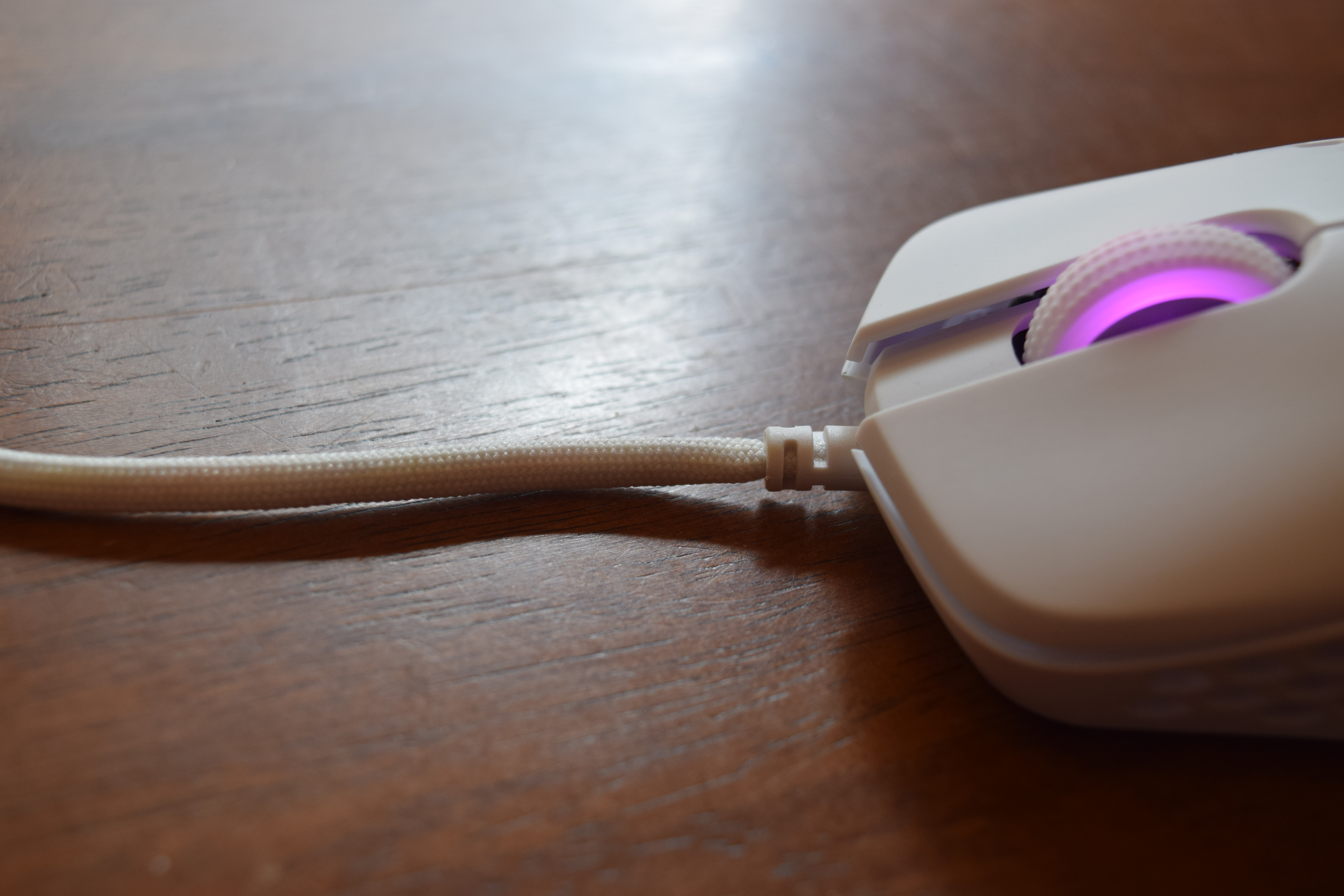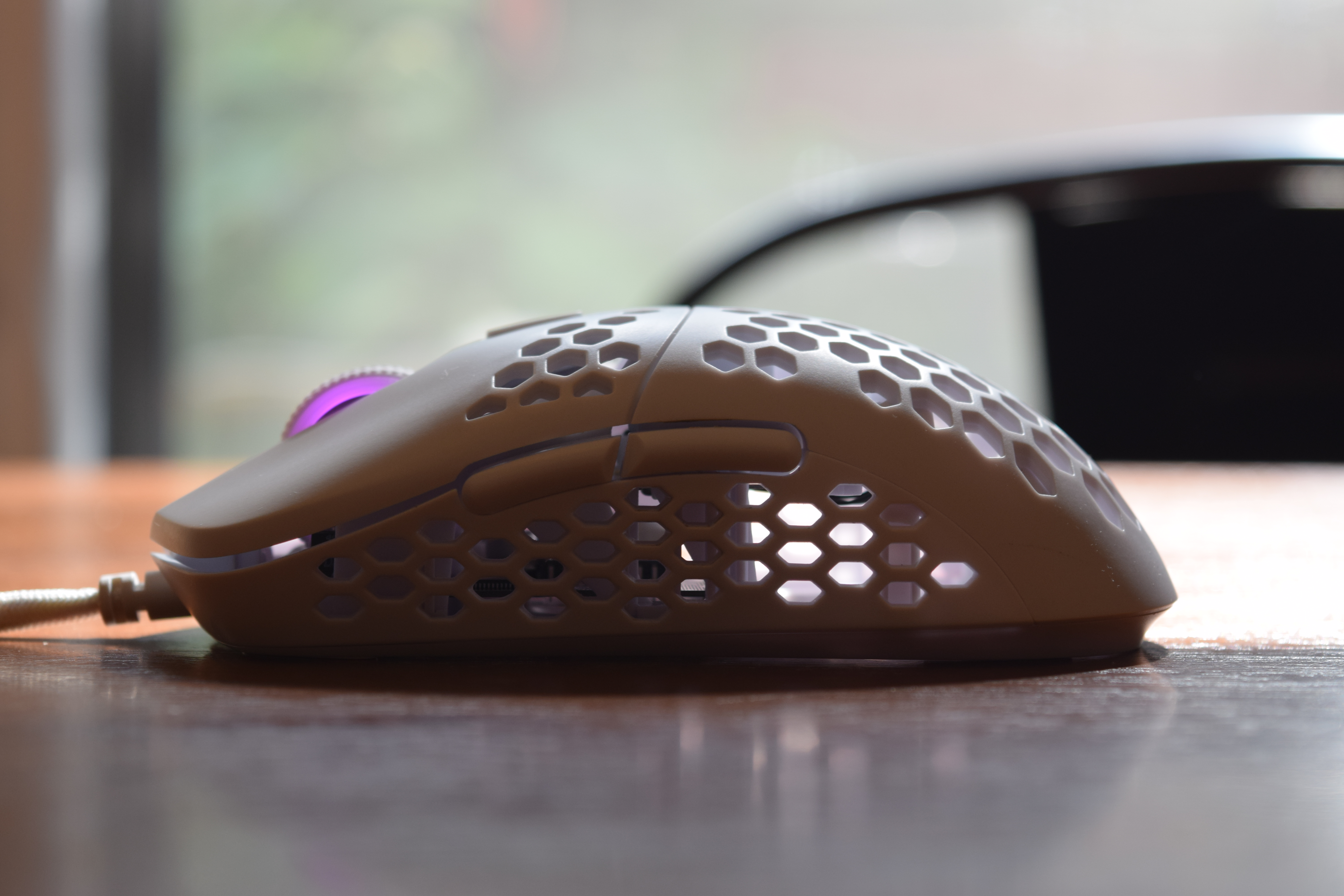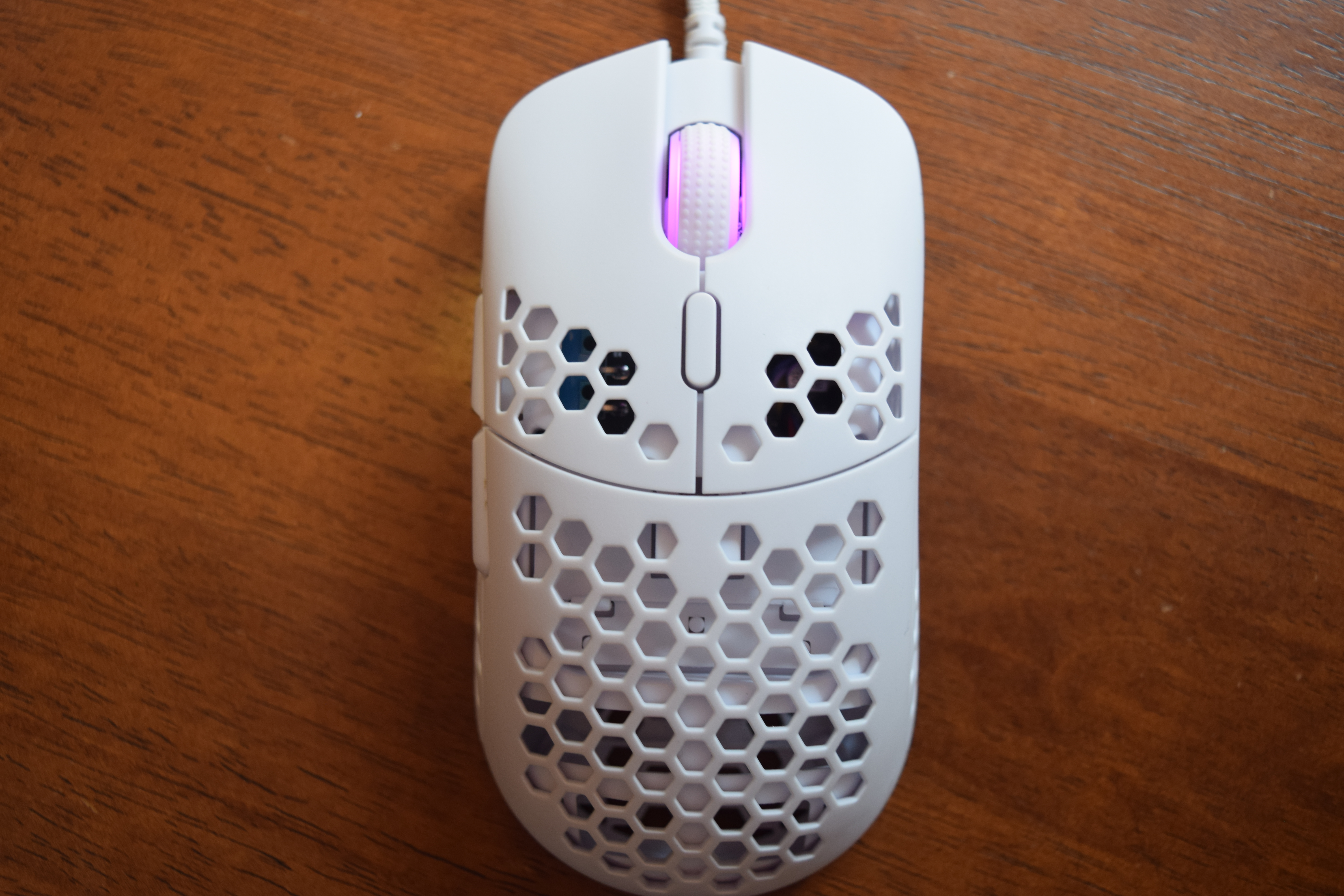Tom's Hardware Verdict
The HK Gaming Mira-M is an excellent mouse for FPS games that combines many best practices -- a quality sensor, paracord cable and ultra lightweight design -- in a shape that many will love.
Pros
- +
Excellent performance
- +
Paracord cable
- +
Solid build quality
- +
Low price
Cons
- -
Side buttons are too low
- -
Mouse acceleration is enabled by default
Why you can trust Tom's Hardware
Let’s go down the list. Honeycomb-inspired shell? Check. Paracord cable? Check. RGB lighting? Check. The HK Gaming Mira-M doesn’t bring anything new to the table, but that isn’t necessarily a bad thing because nearly everything is perfectly executed. And that’s for a mouse that costs just $50. The Logitech G Pro Wireless costs $150 — if you can find it in stock. If you’re looking for the best gaming mouse for first-person shooters (FPS) specifically, the Mira-M should be on your short list.
The HK Gaming Mira-M seems like the answer to a question mouse enthusiasts have asked for years: What would an ultra lightweight Logitech G Pro Wireless be like? The only thing stopping the Mira-M from being the obvious answer is its wired connection and holes. Otherwise, it embodies the gaming mouse industry’s current trends inside a honeycomb-style version of the Logitech G Pro Wireless’ body.
HK Gaming Mira-M Specs
| Sensor Type | Optical |
| Sensor Model | Pixart PMW3360 |
| Sensitivity | Up to 12,000 CPI |
| Polling Rates | 125, 250, 500 or 1,000 Hz |
| Programmable Buttons | 6 |
| LED Zones | 1 RGB zone |
| Cable | ~6 feet (1.82m) paracord |
| Measurements (LxWxH) | 4.88 x 2.52 x 1.55 inches (124 x 64 x 39.5mm) |
| Weight (without cable) | 2.22 ounces (63g) |
Design and Comfort



I wasn’t kidding when I said the Mira-M is HK Gaming’s answer to the G Pro Wireless. The shapes are nearly identical. Both mice are ambidextrous with a pronounced hump in the middle. The G Pro Wireless has buttons on both sides, however, and the Mira-M’s side buttons are only on the left side and are shaped differently. Of course, the Mira-M also has a bunch of holes in its chassis.
But the dimensions between the two mice are essentially the same. The Mira-M is 4.88 inches (124mm) long, 2.52 inches (64mm) wide and 1.55 inches (39.5mm) tall. The G Pro Wireless is 4.92 x 2.48 x 1.57 inches. The primary difference is the weight, with the Mira-M weighing in at 2.22 ounces compared to the G Pro Wireless’ 2.82 ounces, making the Mira-M roughly 21% lighter. That might not seem like a big deal, but it felt very different when it came to gaming.
That lightweight build, which is especially handy for first-person shooter (FPS) titles, is due to its honeycomb style. The Mira-M isn’t the only mouse using this design to its advantage. The Glorious Model O Minus is 2.08 ounces, and the Cooler Master MM711 is 2.12 ounces. Although the Mira-M is a featherweight, there are lighter honeycomb mice out there. However, we tested the Glorious Model D at a heavier 2.40 ounces (the mouse comes with slightly different weights, depending on the selected finish).
The Mira-M also features a paracord cable, 100% PTFE feet and RGB lighting under the scroll wheel. I’m a big fan of the cable; it feels very similar to the Razer Speedflex cable found in pointers like the Razer Viper that I’ve liked in the past. Even without a mouse bungee, I never noticed Mira-M's cable while I’m playing a game. At this point, I doubt I’d be content with a non-paracord cable.
My only complaint about the Mira-M’s design stems from its side buttons. They’re too high for my taste. Depending on your hand shape and size, your opinion could differ. Everything else about the build feels good though. There’s no pre-travel on the side buttons, very minimal pre-travel on the primary mouse button and no post-travel on either. The Mira-M’s casing is solid too, and the scroll wheel doesn’t wobble. HK Gaming built a sturdy gaming mouse.
Get Tom's Hardware's best news and in-depth reviews, straight to your inbox.
The Mira-M is the most aesthetically pleasing mouse I’ve reviewed in a while -- assuming you don’t mind the holes in the case. We’re reviewing it in white, but it’s also available in three other colors: black, bumblebee and pumpkin. Note that the bumblebee and pumpkin variants are $10 more than the black and white ones as of writing.
Finally, the Mira-M sports a matte coating that feels much better in-hand than the coating on other mice I’ve used, even though I’ve been playing during the hot and humid summertime.
Gaming Performance

The Mira-M features the same Pixart PMW3360 optical sensor found in the Glorious Model O Minus and Model D, the Finalmouse Ultralight 2 and other popular mice. That sensor offers up to 12,000 CPI, complemented by a 250 IPS tracking speed and 50G max acceleration. This will prove ample for most gamers.
Anyone who plays FPS titles is doing themselves a disservice if they don’t at least experiment with an ultra lightweight mouse. I previously used the SteelSeries Sensei Ten, which weighs approximately 3.28 ounces and has a rubber cable, and have noticed a significant improvement across a variety of games since I switched to the Mira-M.
The reduced weight’s effect on my performance was so pronounced that I was able to switch my effective CPI (the mouse’s CPI setting multiplied by the in-game sensitivity) in Valorant from 268 with the Sensei Ten to 192 with the Mira-M. That means I have to move the Mira-M more than I had to move the Sensei Ten to cover the same in-game distance. Yet, my response times — as measured by a variety of game modes in Aim Lab — have actually improved since I reduced my effective CPI.
I was also less fatigued after prolonged sessions, even though I’m technically moving the mouse even more than I was before, a testament to the Mira-M’s comfortable design. The Mira-M’s cable didn’t snag on itself either, which is a godsend.
Many gaming mice offer similar performance these days. Sensors have improved to the point where they’re more than good enough for most mainstream users, and even though companies tout minute differences to help sell their products, the reality is that the typical gamer can get reliable performance from most of the sensors used by reputable vendors. That means weight, shape and build quality are even more important.
I’ve come to think of the Mira-M as my Goldilocks mouse. The Razer DeathAdder V2 was too big for me, in large part because of its 1.65 inch (42mm) hump, but the Mira-M’s hump feels just right at 1.56 inches (39.5mm). The Razer Viper felt too small, and I believe that’s because its tallest point is closer to the palm, but the Mira-M’s more forward hump placement makes it a lot more comfortable in my hand.
Again, my primary complaint about the Mira-M is its side buttons. I use them for push-to-talk voice chat, so every time I make a callout, I have to change my grip. This can adversely affect my aim, so now I have to choose between a sub-optimal experience or learning a new key bind. But if that’s the only trade-off I have to make, well, I’m still coming out ahead. And depending on your hand size and shape, you may not have this problem at all.
Features and Software
HK Gaming stumbled a bit with the Mira-M’s software. Windows 10 advised me not to launch the app because HK Gaming isn’t a verified developer. That alone might scare off people. But the bigger problem was the fact that the company enabled a feature it calls “Enhance Pointer Precision” by default, and downloading the software is the only way to disable it.
Enhance Pointer Precision mirrors a Windows 10 setting of the same name that, well, does the exact opposite of what it’s supposed to. Both features enable mouse acceleration, which changes the CPI based on how quickly you move the mouse. Some people like this feature because it allows them to quickly flick across their screens even if they have a low sensitivity.
However, most people should disable mouse acceleration because it makes it hard to acquire the muscle memory needed for precise aim. I’m not opposed to offering mouse acceleration as an option, but enabling by default is ill-advised. Hopefully, future batches will ship with new firmware that doesn’t subject Mira-M buyers to this feature.
HK Gaming’s software is otherwise standard. It makes it easy to assign different key binds, create macros, set up to six different CPI levels and modify the double-click time, scroll speed and polling rate. You can also set the lift-off distance between 2mm and 3mm or change the debounce time from 4ms to 16ms. Finally, you can manage the RGB lighting effects and colors in the app.
Bottom Line
Let’s skip the preamble: The HK Gaming Mira-M is currently my favorite gaming mouse. It’s lighter, more affordable and better suited to my hand than any other mouse I’ve used. Anyone thinking about buying a new mouse should consider it, especially if they mostly play FPS titles because it does so many things right at such a low price point.
But there are stiff competitors out there in the honeycomb-style arena. The Glorious Model O Minus or Cooler Master MM710 would serve people seeking a lighter mouse. But note that the Mira-M and Model O Minus carry the same sensor. Those who prefer ergonomic mice would probably like the Glorious Model D. And for wireless alternatives to the Mira-M, the Razer Viper Ultimate and Logitech G Pro Wireless are hard to beat, despite their higher prices. But the Mira-M’s design, which is light on the RGB and logos and has an exemplary cable, might help you make your decision.
Thanks to its high side buttons and questionable default settings, the Mira-M isn’t perfect. Both are matters of personal preference but precluded me from giving the Mira-M a perfect score. Provided you’re willing to overlook those very slight issues, I seriously recommend giving the Mira-M a shot.
MORE: Best Gaming Mice
MORE: Gaming Mice Reviews
MORE: Best RGB Mouse Pads

Nathaniel Mott is a freelance news and features writer for Tom's Hardware US, covering breaking news, security, and the silliest aspects of the tech industry.
-
Tiptup300 I never realized mouse acceleration works like that. Thank you for the insight, I was able to use a past articale from toms hardware to disable my windows accerlation for my current mouse.Reply
Thank you! -
vMax I thought the Glorious Mouse was first with this design..Reply
Seppapath said:This is a disgusting ripoff of the Finalmouse Ultralight. -
hang-the-9 ReplySeppapath said:This is a disgusting ripoff of the Finalmouse Ultralight.
There are at least 8 models of mice that use holes cut either into fully through or on the inside of the case to lighten the weight, not to mention people that just drilled holes in their mice. Finalmouse got popular first because of streaming.
R.A.T 1 had a light weight cut out design in 2016
TT Ventus also 2016

